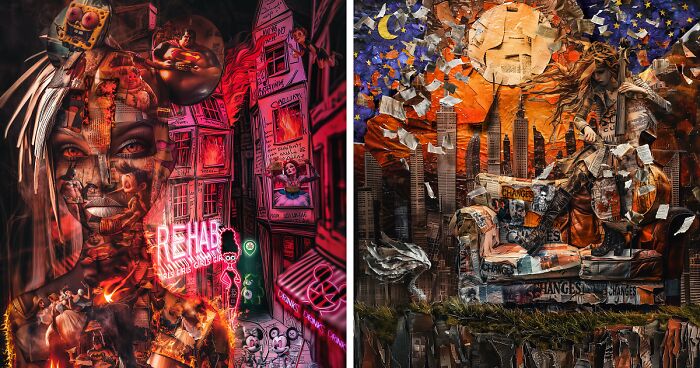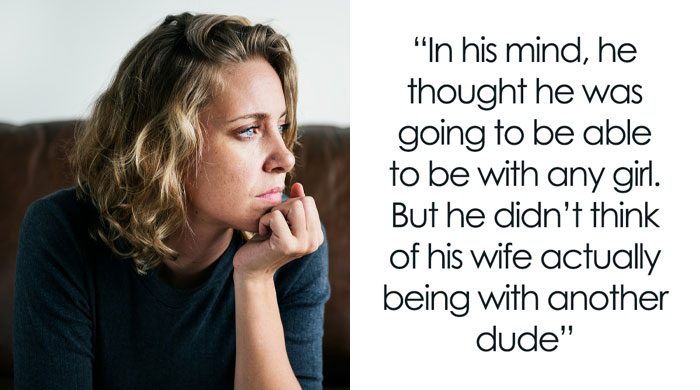
7submissions
Finished
My 7 Surreal Collages That Demand You To Think Differently
My art isn't just decoration; it's a way to challenge, provoke, and make you see the world differently. My work stands out from the sea of generic AI creations or Photoshopped surrealism that's flooding the internet. It’s crafted to pull you in, make you feel something deep, and confront your assumptions head-on. I’m not here to follow trends-I’m here to lead you into stories and symbolism that defy the ordinary. Before diving into my intentions, I challenge you: look at my art, form your own opinions, and let it evoke something within you. If it doesn’t stir your soul, I’ve failed. So, are you ready for the challenge? Let’s dive into eight pieces that just might challenge the way you see the world-and yourself.
More info: surreal24seven.com | Instagram | x.com
This post may include affiliate links.
Satirical Inferno
Step into Satirical Inferno, where childhood innocence collides with the chaos of adulthood. Created by Surreal24seven, this piece features a large woman made from paper mache at its center. Her intense gaze pulls us into the narrative of transformation, as behind her, childhood icons like Mickey Mouse, Minnie Mouse, and Donald Duck are depicted in stark white—stripped of their usual colors. These familiar characters now engage in adult behaviors: Donald smoking weed, Minnie and Mickey drinking, surrounded by cash and guns. The contrast highlights how childhood ideals are reshaped by the adult world.
The dramatic white background, once symbolizing childhood purity, now underscores the loss of innocence and the chaotic reality that follows. Adding a humorous touch, a neon "REHAB" sign with a smaller "drink" sign beneath it suggests that even these icons need a break from life's turmoil—perhaps with a drink in hand.
Flames and burning buildings in the backdrop symbolize the destruction necessary for new beginnings. The fire becomes a metaphor for personal transformation, where outdated identities and societal norms are burned away to make room for rebirth.
Satirical Inferno combines humor with sharp social commentary, exploring the journey from innocence to experience. This thought-provoking artwork invites viewers to laugh at the absurdity while reflecting on how society reshapes our perceptions and identities, encouraging personal growth amid chaos.
Changes
"Changes" – This artwork captures the essence of personal transformation through the intimate connection we share with music. When I was 20, "Miss Misery" by Elliott Smith was the song that marked a pivotal shift in my life. I remember hearing it in a small, intimate venue, the raw emotion in Smith's voice resonating with my own feelings of uncertainty and longing for something more. It was then I decided to move to Los Angeles, drawn by the dream of becoming an actor. The song's melancholy melody seemed to echo through the vibrant, sunlit cityscape behind the violinist in "Changes," each note pushing me towards a life filled with auditions, dreams, and endless possibilities.
In the artwork, the woman playing the violin sits amidst a backdrop of a city skyline, symbolizing the bustling life of LA that awaited me. Her flowing hair and the dynamic action of playing the violin represent the energy and movement of change, much like how I felt propelled forward by the music.
Once in LA, the city was both my stage and my teacher, a place where every corner held a story or a chance. However, the true revelation came during a road trip to Vegas, with "Like a Rolling Stone" by Bob Dylan playing through the speakers. The open road, much like the falling papers in "Changes," felt like a shedding of past layers, revealing something new with every mile. The artwork's depiction of papers falling away to reveal the night sky mirrors this journey of self-discovery, where the bright day of my old life gave way to the profound, starry night of new understanding.
The journey was about embracing change, about understanding that the road to self-discovery is as winding and unpredictable as Dylan's lyrics. Every stop, every new person I met, was a scene in my unfolding narrative, one where I was both the scriptwriter and the protagonist. The collage of newspaper clippings in the artwork, with the word "CHANGES" repeated, signifies the constant evolution and the media's portrayal of change, much like how my life was being rewritten with each new experience.
Now, whenever I hear "Miss Misery" or "Like a Rolling Stone," I'm not just listening to music; I'm revisiting those defining moments. "Miss Misery" takes me back to the vulnerability and courage of starting anew in LA, its chords intertwined with the city's promise. "Like a Rolling Stone" recalls the sense of liberation on the road, the shedding of an old self for the unknown. "Changes" isn't merely art; it's a testament to how music can guide us through our transformations, from the brightness of new beginnings to the reflective beauty of the night sky, showing that every change, every adventure, is a note in the melody of our lives.
You Are Cordially Invited To My Party!
This artwork isn't just a visual feast; it's a narrative steeped in irony, survival, and the redefinition of family.
I've always been fascinated by how rats symbolize intelligence, adaptability, and survival, not just pests, much like the woman in the artwork enjoying a picnic with her pets. There was this one summer when I decided to live life my way, just like the woman hosting this unique party.
I remember hosting a gathering in a small, overgrown backyard, where I, like the woman, chose to be around people who really got me, even if others didn't approve. My friends, like the rats, were seen as outsiders or misfits by some, but to me, they were family, symbols of loyalty and protection. The scene in the artwork, with the woman surrounded by rats, mirrors this sentiment perfectly, with the rats not just as companions but as part of the celebration.
The pest control truck in the background, and the darkly funny image of the pest control man's body under a tree, represents a neighbor who disliked our group. In the artwork, this is vividly depicted with the "Pest Control" truck and the lifeless figure, adding a layer of dark humor to our story. That summer, this neighbor, unhappy with our unique gathering, called the cops on us, thinking we were causing trouble. Instead of running away, we turned the situation around by inviting the officers to our 'party'. In the artwork, the transformation of the pest control man's organs into burgers and cakes, with the meat-based pastries, symbolizes our victory over societal disapproval. It's a bold, dark celebration of overcoming those who try to control or squash what they don't understand, much like how we changed the story to show rats not as pests but as loved friends.
The balloons with X's for eyes, floating above, add a surreal touch, perhaps symbolizing the death of conventional norms or the playful defiance against societal expectations. The word "SURVIVOR" scrawled across the scene resonates with the theme of overcoming adversity, much like we did that summer.
Now, when I see this artwork, it reminds me of that summer, of breaking norms, of celebrating the unconventional, and of the strong family bonds I made. "You are cordially invited to my party!" isn't just about looking at art; it's about questioning, laughing at life's oddities, and celebrating the beauty and strength in what's often ignored or misunderstood. The artwork captures this essence, turning a simple gathering into a statement of resilience and camaraderie.
Bunnie
This artwork vividly brings back memories of a night in LA, a moment etched with the raw pulse of the city, where I, just a naive kid from the suburbs, sought something different from the life I knew.
I found myself in one of those speakeasies tucked away in an alley, where the walls were canvases for graffiti that told tales of rebellion, and the atmosphere was thick with the intoxicating scent of freedom, which to me felt like the purest form of art. It was in this electric environment that I met her, known only as "Bunnie," a name as enigmatic as the neon-lit club we were in. She was enveloped in a cute pink hoodie, her body a canvas of tattoos, each one a story in ink.
The neon glow around her, much like the artwork, highlighted her presence, making her seem like a figure from a dream or a cyberpunk fantasy. Inspired by her, I later incorporated the idea of her with a hoodie with bunny ears and tattoos of bunnies into my own art, creating a "Bunnie" character that encapsulated our meeting's essence – the innocence of her appearance juxtaposed with the complexity of her persona, a symbol of exploration, luck, and the fleeting nature of our connection.
Her tattoos, visible in the artwork's vibrant light, whispered tales of her life's journey, resonating deeply with the message scrawled across the piece, "I feel lucky but also feel sad for the rabbit who does not have a foot," which she shared with a knowing, almost melancholic smile. This phrase, surrounded by the chaotic beauty of graffiti and neon, captured her life's duality – the thrill of living on the edge, the luck of belonging, contrasted by the silent sacrifices that come with urban existence.
Surrounded by tattooed rabbits and cyberpunk toys, the scene was a visual explosion of street culture and personal mythology. The toys, much like the rabbits in her tattoos, added a layer of whimsy to the scene, a reminder of childhood innocence lost in the gritty reality of city life.
Back then, there was no social media to capture these fleeting moments or the people within them, and even today, in moments of wistful curiosity, I type "Bunnie" into search engines, fully aware it's a futile hope to reconnect with the memory of that night, with her, with the raw energy of LA that this artwork so powerfully encapsulates.
Serene Isolation
In the bustling heart of the city, where lights never dimmed and noise was ever-present, I once thrived on the energy of the crowd. When I was younger, being surrounded by friends, drinking, and dancing under the city lights was exhilarating- a rush of excitement that felt like the world was ours. But as time passed, like the woman in "Serene Isolation," I found myself drawn to a different rhythm-the quiet of my own space. Her cabin, perched high above the clouds, symbolizes my soul's ascent from the chaos of nightlife to a tranquil solitude. The city lights below, once a symbol of freedom and belonging, now remind me of what I've left behind.
The artwork's warm, ethereal glow mirrors my journey from social vibrancy to introspective peace. The cabin's rustic simplicity contrasts with the modern skyline, emphasizing the choice between the allure of connection and the serenity of solitude. Her flowing dress, dancing with the wind, signifies freedom from societal expectations and the ever-present fear of missing out.
The ladder to the cabin represents the deliberate journey to inner peace, both physical and spiritual, highlighting the effort needed for self-discovery. The reflection of the cabin in the clouds adds a surreal touch, portraying peace as both tangible and dreamlike—a balance between longing and fulfillment.
"Serene Isolation" celebrates solitude as a choice, not a sentence of loneliness. It reflects my transformation, from the dazzling nights of my youth to a deeper, quieter understanding of who I am. It’s a testament to the strength found in stepping away from the noise, embracing the stillness, and finding liberation in simply being.
Not Your Princess (Pilot)
In "Not Your Princess (Pilot)," a tattooed woman pilot sits on a runway, her bold tattoos contrasting with her bruised, scarred skin, symbolizing strength and resilience. Behind her, a graffiti-covered plane reflects defiance and empowerment, blending street art with aviation. Her posture and attire challenge conventions, showing a life lived on her terms.
"Not Your Princess (Pilot)" is a striking piece that challenges the conventions of femininity and power. It celebrates female strength in an unapologetic style, where the runway isn't just a path for takeoff but a stage for showcasing one's true self. This lowbrow and pop art-infused artwork invites us to rethink the narrative of what it means to be a woman in a world that often tries to define them, reminding us that empowerment comes from embracing our uniqueness, our scars, and our stories, flying high above societal expectations.
Finding Prince Charming
In "I'm Not Your Princess," we're presented with a modern, humorous reinterpretation of the age-old fairy tale quest for Prince Charming. The princess, covered with tattoos and exuding a rebellious vibe, lounges on a luxurious, fur-lined throne, her presence accentuated by an electric pink glow that underscores her defiance. Her bright lips leave bold lipstick marks on the frogs around her, each kissed in a playful attempt at transformation. Yet, none morph into her prince, poking fun at the traditional fairy tale expectation.
This artwork cleverly critiques the cliché of kissing frogs to find love, turning it into a commentary on modern relationships and self-empowerment. It champions the notion that completeness doesn't require a prince; it's about embracing one's own identity. The lowbrow, pop art aesthetic, with its vibrant hues and whimsical details, layers the piece with satire and empowerment, making a bold, unapologetic statement on contemporary femininity and the pursuit of love on one's own terms.

 Dark Mode
Dark Mode 

 No fees, cancel anytime
No fees, cancel anytime 




































































